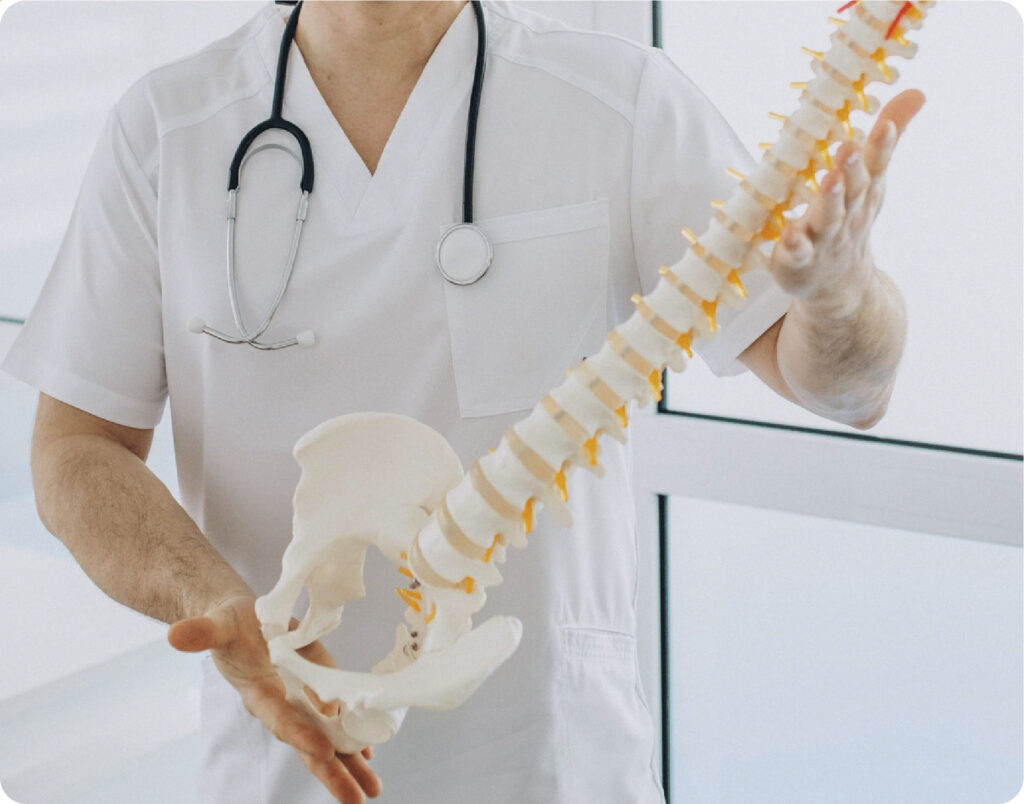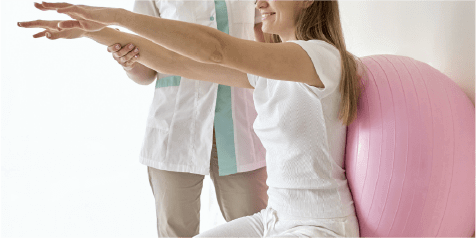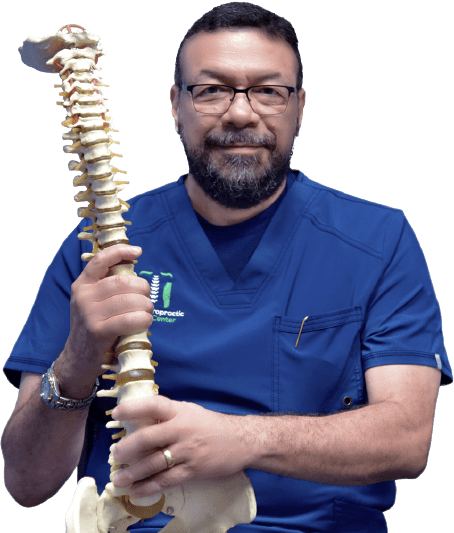El Doctor Habla Español
Introduction
The human body is an incredible machine. Each of its parts work harmoniously to maintain our well-being.
Every single cell, tissue, organ and system in our body work under the direction of the Central Nervous System, which is formed by the brain and spinal cord. Just how the brain is protected by the skull, our spinal cord is housed and protected by the vertebral column. Maintaining the integrity of the vertebral column will assure a much better communication between the central nervous system and the rest of our body, favoring a better functioning of our body.
Trauma like automobile accidents, sport injuries, falls, obesity, bad posture and stress are only a few occurrences that can easily disrupt the integrity and functioning of your vertebral column resulting in pain, decreased range of motion, fatigue and other serious health issues.
At Lucha Chiropractic Quality Center, we proudly serve our community by relieving pain and symptoms and walking you through the path of healing and well-being. Our mission for you is to live pain free and to unleash your body’s full potential with professional and caring chiropractic care.
-Dr. Samuel Lucha


Automobile Accidents
Automobile accidents are a frequent source of
injuries that can range from mild to very
severe. The State of Florida has one of the
highest rates of incidence of automobile
accidents in the nation, and at any point we
could be exposed to them.

Wellness Care
The human body is a machine that has been
designed and built to function perfectly. But
even this, the most wonderful machine ever
built, needs maintenance to continue
functioning properly.
Services:
• Chiropractic Adjustment
• Mechanical Traction
• Electrical Muscle Stimulation (EMS)
• Transcutaneous Electrical Nerve Stimulation (TENS)
• Therapeutic Ultrasound
• Heat Therapy
• Ice Therapy
• Flexion Distraction
• Chiropractic Adjustment
The chiropractic adjustment is a non-invasive procedure performed
by a Doctor of Chiropractic. The patient may be required to lie down
on a chiropractic adjusting bench and be positioned in a certain way.
Then the Doctor will gently contact the patient’s spine with his/her hands and deliver a very controlled, high-speed but low force thrust in a specific direction to correct a subluxation or vertebral misalignment. The adjustment of one segment of the spine takes literally just seconds. Frequently, a “popping” sound may be heard.
The chiropractic adjustment focuses on restoring the spine to its proper structural mechanics and integrity while decreasing pain, nerve irritability, muscle spasm, and increasing range of motion.
There are several chiropractic techniques to adjust the spine; some of them may require the use of special tools or equipment, but all of them work in helping your spine function better.
There are several chiropractic techniques to adjust the spine; some of them may require the use of special tools or equipment, but all of them work in helping your spine function better.
• Mechanical Traction
Besides being good for your spine, you will find this therapy very
relaxing. The patient lies down on his/her back on a flat bed which is
equipped with a mechanism of moving rollers. When activated, the
rollers move up and down the spine stretching paravertebral
muscles and ligaments. Along with this action, the spaces between
vertebrae expand, favoring nutrition, oxygenation, and hydration of
the intervertebral discs, helping in their healing process (if injured)
or in keeping them healthy for a longer time.
• Electrical Muscle Stimulation (EMS)
During this therapy, electrodes (adhesive pads) are placed over the area of interest.
They are connected to the EMS device. When the EMS is activated, mild electrical impulses are generated, stimulating the skeletal muscle and causing it to contract.
They are connected to the EMS device. When the EMS is activated, mild electrical impulses are generated, stimulating the skeletal muscle and causing it to contract.
The EMS device has different settings and depending on which is being used, the muscle contraction could be barely noticeable or could be easily felt. The repeated contraction of the muscle fibers over a treatment period will cause the muscle to fatigue and then relax.
This therapy can help in reducing pain, muscle spasm, prevent/reverse muscular atrophy, and can even be used by athletes as recovery following a performance.
This therapy can help in reducing pain, muscle spasm, prevent/reverse muscular atrophy, and can even be used by athletes as recovery following a performance.
• Transcutaneous Electrical Nerve Stimulation (TENS)
Like the EMS therapy, TENS therapy requires electrodes (adhesive
pads) to be placed over the area of interest. These are connected
to the TENS unit, which once activated deliver electrical impulses
which travel across the skin and muscle reaching the nerves. This
nerve stimulation raises the levels of endorphins, which are known
as the “body’s natural pain killer chemicals”. The increased levels of
endorphins then block the perception of pain.
This therapy can be used in the treatment of acute (short-lasting)
pain or chronic (long-lasting) pain.
• Therapeutic Ultrasound
This is a deep heating modality of treatment. The ultrasound
transducer head will be used, along with a gel acting as a conductivity
medium which is applied to the area of interest. When the therapy is
performed, sound waves (vibrating energy) travel across the tissues.
When the energy within the sound wave passes through tissues
(matter), the particles of these tissues oscillate, generating heat
energy. The deep heat produced will speed up the healing process of
the injured tissues. It is important to understand that in this therapy,
no heat is being applied, it is generated internally.
• Heat Therapy
Heat promotes dilation (widening) of the blood vessels, allowing
more blood to come to the area of treatment. This blood carries
oxygen and nutrients to our cells and tissues, which favor the
healing process. Heat can help in reducing pain and muscle spasms.
• Ice Therapy
Ice promotes vasoconstriction (narrowing) of blood vessels, which will
cause less blood flow to the area of treatment. Ice therapy can help
you in decreasing pain, inflammation, and swelling.
• Flexion Distraction
This treatment can help you with a broad variety of conditions
affecting your neck and back, including muscle spasms, chronic neck
and back pain, sciatica, and symptoms like tingling/numbness/pain in
the upper and lower extremities provoked by cervical and lumbar
herniated discs.
Both, flexion, and distraction (decompression) of a segment of your
spine promote nutrition, hydration, and oxygenation of the
intervertebral disc by decreasing the internal pressure of this,
facilitating its healing. Also, these procedures may help in eliminating
nerve pressure/irritation caused by a herniated or bulged disc.
For people suffering from disc herniations, Flexion-Distraction
(Decompression) is an excellent, non-invasive alternative to surgery.
• Chiropractic Adjustment
• Mechanical Traction
• Electrical Muscle Stimulation (EMS)
• Transcutaneous Electrical Nerve Stimulation (TENS)
• Therapeutic Ultrasound
• Heat Therapy
• Ice Therapy
• Flexion Distraction
• Chiropractic Adjustment
The chiropractic adjustment is a non-invasive procedure performed
by a Doctor of Chiropractic. The patient may be required to lie down
on a chiropractic adjusting bench and be positioned in a certain way.
Then the Doctor will gently contact the patient’s spine with his/her hands and deliver a very controlled, high-speed but low force thrust in a specific direction to correct a subluxation or vertebral misalignment. The adjustment of one segment of the spine takes literally just seconds. Frequently, a “popping” sound may be heard.
The chiropractic adjustment focuses on restoring the spine to its proper structural mechanics and integrity while decreasing pain, nerve irritability, muscle spasm, and increasing range of motion.
There are several chiropractic techniques to adjust the spine; some of them may require the use of special tools or equipment, but all of them work in helping your spine function better.
There are several chiropractic techniques to adjust the spine; some of them may require the use of special tools or equipment, but all of them work in helping your spine function better.
• Mechanical Traction
Besides being good for your spine, you will find this therapy very
relaxing. The patient lies down on his/her back on a flat bed which is
equipped with a mechanism of moving rollers. When activated, the
rollers move up and down the spine stretching paravertebral
muscles and ligaments. Along with this action, the spaces between
vertebrae expand, favoring nutrition, oxygenation, and hydration of
the intervertebral discs, helping in their healing process (if injured)
or in keeping them healthy for a longer time.
• Electrical Muscle Stimulation (EMS)
During this therapy, electrodes (adhesive pads) are placed over the area of interest.
They are connected to the EMS device. When the EMS is activated, mild electrical impulses are generated, stimulating the skeletal muscle and causing it to contract.
They are connected to the EMS device. When the EMS is activated, mild electrical impulses are generated, stimulating the skeletal muscle and causing it to contract.
The EMS device has different settings and depending on which is being used, the muscle contraction could be barely noticeable or could be easily felt. The repeated contraction of the muscle fibers over a treatment period will cause the muscle to fatigue and then relax.
This therapy can help in reducing pain, muscle spasm, prevent/reverse muscular atrophy, and can even be used by athletes as recovery following a performance.
This therapy can help in reducing pain, muscle spasm, prevent/reverse muscular atrophy, and can even be used by athletes as recovery following a performance.
• Transcutaneous Electrical Nerve Stimulation (TENS)
Like the EMS therapy, TENS therapy requires electrodes (adhesive
pads) to be placed over the area of interest. These are connected
to the TENS unit, which once activated deliver electrical impulses
which travel across the skin and muscle reaching the nerves. This
nerve stimulation raises the levels of endorphins, which are known
as the “body’s natural pain killer chemicals”. The increased levels of
endorphins then block the perception of pain.
This therapy can be used in the treatment of acute (short-lasting)
pain or chronic (long-lasting) pain.
• Therapeutic Ultrasound
This is a deep heating modality of treatment. The ultrasound
transducer head will be used, along with a gel acting as a conductivity
medium which is applied to the area of interest. When the therapy is
performed, sound waves (vibrating energy) travel across the tissues.
When the energy within the sound wave passes through tissues
(matter), the particles of these tissues oscillate, generating heat
energy. The deep heat produced will speed up the healing process of
the injured tissues. It is important to understand that in this therapy,
no heat is being applied, it is generated internally.
• Heat Therapy
Heat promotes dilation (widening) of the blood vessels, allowing
more blood to come to the area of treatment. This blood carries
oxygen and nutrients to our cells and tissues, which favor the
healing process. Heat can help in reducing pain and muscle spasms.
• Ice Therapy
Ice promotes vasoconstriction (narrowing) of blood vessels, which will
cause less blood flow to the area of treatment. Ice therapy can help
you in decreasing pain, inflammation, and swelling.
• Flexion Distraction
This treatment can help you with a broad variety of conditions
affecting your neck and back, including muscle spasms, chronic neck
and back pain, sciatica, and symptoms like tingling/numbness/pain in
the upper and lower extremities provoked by cervical and lumbar
herniated discs.
Both, flexion, and distraction (decompression) of a segment of your
spine promote nutrition, hydration, and oxygenation of the
intervertebral disc by decreasing the internal pressure of this,
facilitating its healing. Also, these procedures may help in eliminating
nerve pressure/irritation caused by a herniated or bulged disc.
For people suffering from disc herniations, Flexion-Distraction
(Decompression) is an excellent, non-invasive alternative to surgery.
ABOUT
THE DOCTOR
ABOUT
THE DOCTOR

Dr. Samuel E.Lucha has practiced chiropractic for close to 20
years. Posterior to his bachelor’s degree in microbiology from
California State University, Sacramento, he was accepted at Life
Chiropractic College West, Hayward, California, where he
completed his Chiropractic education and from where he
graduated with the Magna Cum Laude distinction in 2001.
Location
1320 Louisiana Avenue,
Suite D. St. Cloud, FL. 34769
Suite D. St. Cloud, FL. 34769

